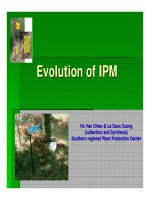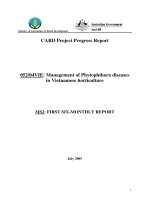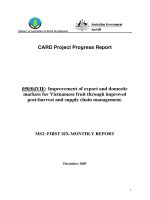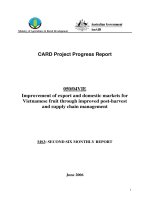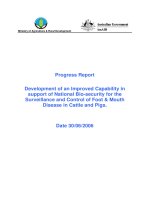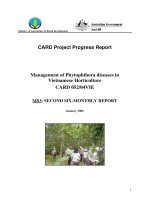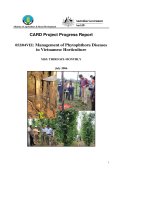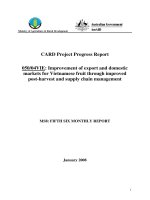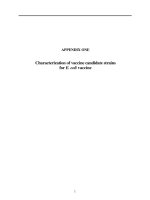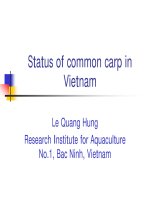Báo cáo nghiên cứu khoa học: " CHARACTERIZATION OF PROTEASE FROM ASPERGILLUS ORYZAE SURFACE CULTURE AND APPLICATION IN FISH SAUCE PROCESSING" pps
Bạn đang xem bản rút gọn của tài liệu. Xem và tải ngay bản đầy đủ của tài liệu tại đây (352.82 KB, 6 trang )
TẠP CHÍ PHÁT TRIỂN KH&CN, TẬP 9, SỐ 5 -2006
Trang 53
CHARACTERIZATION OF PROTEASE FROM ASPERGILLUS ORYZAE
SURFACE CULTURE AND APPLICATION IN FISH SAUCE PROCESSING
Le Van Viet Man, Tran Thi Anh Tuyet
Department of Food Technology, University of Technology, VNU-HCM
(Manuscript Received on August 08
th
, 2005, Manuscript Revised May 17
th
, 2006)
ABSTRACT: Some kinetic parameters of the purified protease from Aspergillus oryzae
surface culture were determined: K
m
=634.5mg/L and V
max
=13.98mg/L.min. Ions Na
+
, Zn
2+
and
Fe
3+
had an inhibitor effect to the enzyme activity. On the contrary, ion Mg
2+
had an activator
effect. The influence of ion Ca
2+
to the protease activity was more complicated. With low
concentration (0.005M), this ion activated the protease; but with higher concentration (0.01M),
it inhibited the enzyme activity. The purified protease was applied in fish sauce processing for
proteolysis acceleration. High salt content (25%) in the fish-salt mixture decreased obviously
the enzyme activity. Addition of salt and fungal protease to the fish sample with several times
accelerated significantly fish proteolysis.
1. INTRODUCTION
Fish sauce has been a traditional product in Vietnam. Production time of fish sauce varies
from 6 to 12 months. Application of microbial protease in fish sauce processing permits to
decrease the production time and increase the equipment productivity (Steinkraus K. H., 1983).
Salt tolereance is an important charactersitics of commercial protease used in fish sauce
processing. Different commercial enzymes with high protease activity cannot be used in fish
sauce processing because the enzymes are non salt-tolerant. These proteases are significantly
inhibited by a salt concentration of 10-20%.
Aspergillus oryzae can produce salt-tolerant protease. In some Asian countries, this fungi
has widely been applied in the production of different traditional fermented foods with high salt
content such as soy bean sauce.[3]
This study focussed on the characterization of protease from
Aspergillus oryzae surface
culture. Firstly, the influence of different ions to the enzyme activity was examined. Then the
kinetic parameters K
m
and V
max
of the obtained protease were determined. Finally, the enzyme
was applied in fish sauce processing for decrease of proteolysis time.
2. MATERIALS AND METHODS
2.1. Materials
Micro-organism: A strain of Aspergillus oryzae from the Culture collection of Food
Microbiology Laboratory, Department of Food Technogy, Ho Chi Minh City University of
Technology was used. Rice bran (Starch – 15.3%, crude protein – 14.8%) and soy meal (Crude
protein – 38.5%) were used as medium substrates for protease biosynthesis by
A. oryzae.
Anchovy fish (Crude protein – 15.8%) was used in fish sauce fermentation. Chemicals used
in this study were supplied by Sigma, Merck and a Chinese company.
2.2. Protease production from Aspergillus oryzae surface culture
Medium composition for protease biosynthesis: Medium contained rice bran – 83%, soy
meal – 12.7% and rice husk - 4.3%. Initial moisture of the medium was 50%. Medium was
sterilized at 120
o
C for 20 minutes [2]
Conditions for protease biosynthesis: stainless steel cuvets (200*400*5mm) were used for
solid state fermentation. Medium in cuvet was inoculated by a spore suspension of
A. oryzae.
Science & Technology Development, Vol 9, No.5 - 2006
Trang 54
Medium height in cuvet was not exceed 3mm. Solid state fermentation was carried out at 30
o
C
for 48 hours. [2]
Protease extraction: The optimal conditions for protease extraction from A. oryzae surface
culture were as follows: solvent – phosphate buffer (pH = 6.5), ratio of surface culture and
solvent – 1/8 (w/w), temperature – 20
o
C, time – 35 minutes, agitation speed – 200rpm. After
the enzyme extraction, the sample was centrifuged at 5
o
C for 20 minutes for eliminating the
biomass and non solubles subtances. [2]
Protease purification: Enzyme was precipitated by organic solvent. The ratio of crude
enzyme extract and ethanol 95% was 65/35 (v/v). The protease recovery yield was 65.45% and
the purified degree was 3.03. This purified protease was used for determination of K
m
, V
max
and applied in fish sauce processing.
2.3. Determination of kinetic parameters K
m
and V
max
Serum bovine albumine was used as a substrate. The substrate concentration varied from
100 – 5000mg/L. The enzyme concentration was fixed: 0.1 units per 1g albumine. The
proteolysis was carried out at 50
o
C, pH = 7.0.
Product of proteolysis was evaluated by free amino nitrogent content. From the
experimental data, the kinetic equation of free amino nitrogen accumulation was determined
by Excel software. K
m
and V
max
were determined by Lineweaver – Burk method .[1]
2.4. Application of fungal protease in fish sauce processing
Each sample contained 100g anchovy fish. The purified protease from A. oryzae was added
with different contents and at various moments of the fish sauce fermetation according to each
experiment.
2.5. Analytical methods
- Protease activity was determined by modified Anson method.
- Enzyme protein was quantified by Lowry method, using Serum Bovine Albumine as a
standard.
- Crude protein contents in fish, rice bran and soy meal were determined by Kjeldahl
method.
- Amino nitrogen was quantified by spectrophotometric method using ninhydrin reagent.
3. RESULTS AND DISCUSSION
Our prelimenary study shows that the optimal pH and temperature of the protease produced
by
Aspergillus oryzae surface culture are 7.0 and 50
o
C respectively. In addition, the enzyme is
fairly salt-tolerant. In the sample with NaCl 50g/L and 100g/L, the enzyme activity remained
70% and 50% in comparison with the control sample.[2]
3.1. Influence of different ions to the protease activity
Figures 1 and 2 show the influence of some popular ions in food processing to the relative
activity of protease from
A. oryzae surface culture. Fe
3+
, Zn
2+
, Ca
2+
and Mg
2+
in sulfate and
chloride salts 0.005M were used in this study. It was noted that in both cases, ion Mg
2+
activated the enzyme. On the contrary, ions Fe
3+
, Zn
2+
inhibited the protease acivity. In the
presence of sulfate ion, the enzyme was stronger inhibited by Fe
3+
, Zn
2+
than in the presence of
chloride ion. With regard to the ion Ca
2+
, its influence to the enzyme catalysis was more
complicated. In the presence of chloride ion, ion Ca
2+
was an enzyme activator. But in the
presence of sulfate ion, the content of ion Ca
2+
0.005M did not affect to the enzyme activity.
The influence of the 4 ions above with higher concentration (0.01M) to the protease activity
is visualized in figures 3 and 4. Ion Mg
2+
increased the catalytic activity of the enzyme.
TẠP CHÍ PHÁT TRIỂN KH&CN, TẬP 9, SỐ 5 -2006
Trang 55
However, the higher the concentration of ion Mg
2+
, the lower the activation effect. Three ions
Fe
3+
, Zn
2+
, Ca
2+
in both sulfate and chloride salts decreased the enzyme activity. The highest
inhibitor effect belonged to ion Fe
3+
.
It can be noted that the higher the concentrations of the ions, the higher the inhibition
effects to the protease activity. For explaining this phenomenon, a study of the enzyme
structure is essential. In food processing, different ions are presented in raw materials and
water. Study of ion modulators permits to regulate efficiently the enzymatic reactions in
industrial scale.
3.2. Determination of kinetic parameters K
m
and V
max
The kinetic parameters K
m
and V
max
were calculated from the 1/S against 1/V plot by
Lineweaver – Burk method, using initial reaction rates for different concentrations of substrates
(Figure 5). They were found to be 634.45 mg/L and 13.99 mg/L.min respectively. The same
kinetic parameters were also observed for other commercial prteases.[1]
Figure 6 presents the relation between substrate concentration and reaction rate. The
protease from
A. oryzae surface culture followed a typical type of Michaelis – Menten kinetics.
It shows that if the protein concentration in the proteolytic sample was about 5 – 10 g/L, the
reaction rate reached maximum.
3.3. Application of fungal protease in fish sauce processing
In fish sauce fermentation, proteolysis is carried out by 2 enzyme sources: protease in the
digestion systems of fish and the protease produced by the micro-organisms existed on fish.
Addition of commercial proteases, for example – protease from Bacillus subtilis - could
decrease the proteolytic time.
Nevertheless, high ratio of salt/fish (25% w/w) in fish sauce fermentation prolonged the
proteolysis. In this experiment, procedure of salt addition in fish sauce fermentation was
studied. Three samples S1, S2 and S3 were examined. The experimental plan is given in table
1. The final ratio of salt/fish in the three sample were the same – 25%. The purified protease
from
A. oryzae was added: 0.075 units/g fish protein.
Table 1. Procedure of salt addition - Experimental plan
Sample 1 (S1) Sample 2 (S2) Sample 3 (S3)
Time (days)
Salt addition – Ratio salt/fish (w/w)
0 5 10 15
1 5 10 10
2 5 5
3 5
4 5
Figure 7 illustrates the obtained results. After 1 day, the ratio of salt/fish in sample S3
reached maximum (25%). The proteolysis seemed to be stopped after the first 2 days.
Prolongation of fermentation time (more than 2 days) did not increase free amino nitrogen
content in the sample. It can be confirmed that high concentration of salt inhibited the protease
acitivity. The maximal free amino nitrogen content in sample S3 was about 5.18g/L.
In sample S2, after 2 days, the ratio of salt/fish reached maximum (25%). The proteolysis
slowed down after the first 3 days. The maximal free amino nitrogen content in sample S2 was
6.32g/L - 22% higher than that in sample S3.
Science & Technology Development, Vol 9, No.5 - 2006
Trang 56
Regard to sample S1, after the first 4 days, salt addition was completed. The proteolysis
continued up to the 5
th
day. The free amino nitrogen concentration was the highest (11.64 g/L).
It was 125% and 84% higher than those in samples S3 and S2 respectively. In summary,
procedure of salt addition in fish sauce processing is very important. The procedure in the
sample S1 seems to be satisfied for both purposes: inhibiting the contaminated and pathogenic
micro-organisms in fish and maintaining the protease acitivity during the fermentation.
Fig. 1: Influence of Fe
3+
, Zn
2+
, Ca
2+
and Mg
2+
sulfate salt 0.005M) to the protease activity
Fig. 2: Influence of Fe
3+
, Zn
2+
, Ca
2+
and
Mg
2+
(chloride salt 0.005M) to the protease
activity
Fig. 3: Influence of Fe
3+
, Zn
2+
, Ca
2+
and Mg
2+
(sulfate salt 0.01M) to the protease activity
Fig. 4: Influence of Fe
3+
, Zn
2+
, Ca
2+
and Mg
2+
(chloride salt 0.01M) to the protease activity
Fig.5: Lineweaver - Burk plot of experimental
data for protease from A. oryzae surface culture:
K
m
= 634.45 mg/L; V
max
=13.99 mg/L.min)
Fig.6: Relation between substrate
concentration and reaction rate (protease
concentration: 5 units/ g protein
In the next experiment, various contents of exogenous protease was added to the fish
sample at different moments of the fermentation.The experimental plan is presented in table 2.
Fe
2
(S O
4
)
3
85.18
ZnSO
4
84.46
CaSO
4
99.73
MgSO
4
112.18
0
20
40
60
80
100
120
Relative activity
(% of control sample
)
Fe C l
3
88.64
ZnC l
2
97.00
CaCl
2
107.00
MgCl
2
113.91
0
20
40
60
80
100
120
Relative activity
(% of control sampke)
Fe
2
(SO
4
)
3
73.79
ZnS O
4
81.69
CaSO
4
89.23
MgSO
4
104.22
0
20
40
60
80
100
120
Relative activity
(% of control sample
)
Fe C l
3
78.91
ZnC l
2
89.86
CaCl
2
98.20
MgCl
2
108.71
0
20
40
60
80
100
120
Relative activity
(% of control sample
)
(1/V) = 45.363*(1/S) + 0.0715
0
0.04
0.08
0.12
0 0.0004 0.0008 0.0012
1/S [1/(mg/L)]
1/V [1/ (mg/min)]
0
4
8
12
16
0 5000 10000 15000 20000 25000 30000
S (mg/L)
V (mg/L.min)
TẠP CHÍ PHÁT TRIỂN KH&CN, TẬP 9, SỐ 5 -2006
Trang 57
The procedure of salt addition was carried out as in the sample S1. The obtained results are
given is fugure 8.
Table 2. Influence of exogenous protease content to fish proteolysis - Experimental plan
Sample 4
(S4)
Sample 5
(S5)
Sample 6
(S6)
Sample 7
(S7)
Sample 8
(S8)
Time (days)
Exogenous protease addition – Units/g fish protein
0 0.004 0.008 0.012 0.016 0.02
2 0.004 0.008 0.012 0.016 0.02
4 0.004 0.008 0.012 0.016 0.02
6 0.004 0.008 0.012 0.016 0.02
Total content of
fungal protease
0.016 0.032 0.048 0.064 0.080
Fig. 7: Influence of salt addition procedure to the
evolution of free amino nitrogen content during
fish proteolysis
Fig. 8: Influence of protease content from A.
oryzae to the evolution of free amino nitrogen
concentration during fish proteolysis
Figure 8 shows that the higher the content of exogenous protease, the stronger the
proteolysis and the higher the free amino nitrogen in the sample. However, the content of the
commercial protease was limited because of economic reasons.
For the control sample without exogenous enzyme, after the first 7 days, the free amino
nitrogen was about 4 g/L. In comparison with sample S8, it reached 11.69 g/L – 192% higher
than that in the control sample. The protease from
A. oryzae surface culture was therefore very
suitable in fish sauce processing for proteolysis acceleration.
4. CONCLUSION
Some characteristics of the protease from A. oryzae surface culture were determined. The
kinetic parameters were as follows: K
m
= 634.45 mg/L, V
max
= 13.99 mg/L.min. The ion Mg
2+
in concentration of 0.005M and 0.01M activated enzyme. On the contrary, the ions Fe
3+
, Zn
2+
and Ca
2+
in concentration of 0.01M decreased the enzyme activity.
This protease was fairly salt-tolerant. The application of this enzyme with a suitable
procedure of salt addition in fish sauce processing accelerated fish proteolysis and increased the
free amino nitrogen content. Our research continued on optimization of technological
parameters of fish proteolysis for amelioration of free amino nitrogen content and flavour of
fish sauce.
0
3
6
9
12
15
02468
Time (days)
Free amino nitrogen (g/L)
S1
S2
S3
0
3
6
9
12
15
02468
Time (days)
Free amino nitrogen (g/L)
S4
S5
S6
S7
S8
Science & Technology Development, Vol 9, No.5 - 2006
Trang 58
KHẢO SÁT MỘT SỐ TÍNH CHẤT CỦA CHẾ PHẨM PROTEASE TỪ CANH
TRƯỜNG NUÔI CẤY BỀ MẶT ASPERGILLUS ORYZAE VÀ ỨNG DỤNG
ENZYME TRONG SẢN XUẤT NƯỚC MẮM
Lê Văn Việt Mẫn, Trần Thị Ánh Tuyết
Bộ môn Công nghệ Thực phẩm, Trường Đại học Bách khoa, ĐHQG-HCM
TÓM TẮT: Các thông số động học của chế phẩm protease từ canh trường Aspergillus
oryzae đã được xác định: Km=634.5mg/L và Vmax=13.98mg/L.min. Kết quả thực nghiệm cho
thấy ion Na
+
, Zn
2+
và Fe
3+
đều là những tác nhân ức chế hoạt tính enzyme. Ngược lại, ion Mg
2+
là tác nhân hoạt hóa. Sự ảnh hưởng của ion Ca
2+
đến hoạt tính chế phẩm protease theo một
quy luật phức tạp hơn. Ở nồng độ thấp (0.005M), ion Ca
2+
làm tăng hoạt tính enzyme, nhưng ở
nồng độ cao (0.01M), ion Ca
2+
lại ức chế khả năng xúc tác của protease. Tiếp theo, chúng tôi
thử ứng dụng chế phẩm protease trong sản xuất nước mắm nhằm rút ngắn thời gian thủy phân
protein. Nồng độ cao của muối trong chượp (25% khối lượng) đã làm giảm hoạt tính xúc tác
của chế phẩm. Việc áp dụng chế độ bổ sung muối và chế phẩm protease nhiều lần vào chượp
sẽ làm rút ngắn đáng kể th
ời gian thủy phân protein cá trong chượp.
REFERENCES
[1]. Bailey J. E., Ollis D .F, Biochemical engineering fundamentals, Mc Graw-Hill Inc.,
New-york, 963p, 1986.
[2].
Dinh Tran N. T., Le Van Viet Man, Truong T. B.Y., Le M. D, Study of surface culture
for protease biosynthesis from Aspergillus oryzae,
Proceedings of the 8
th
ASEAN Food
Conference, Agricultural Publishing House, Hanoi, pp. 139-144 , 2003.
[3].
Fogarty W.M, Microbial enzymes and biotechnology, Applied Science Publishers,
London, 317p, 1983.
[4].
Helrich K., Official methods of analysis of the Association of Official Analytical
Chemists
– AOAC, Association of official analytical chemists Inc., Virginia, 1298p. ,
1992.
[5].
Le Van Viet Man, Dinh Tran N. T., Le Thuy M.H. Protease precipitation from the
extract of A. oryzae surface culture and determination of some charactiristics of the
obtained enzyme
. Journal of Science and Technology development, Vol. 8(6), 2005.
